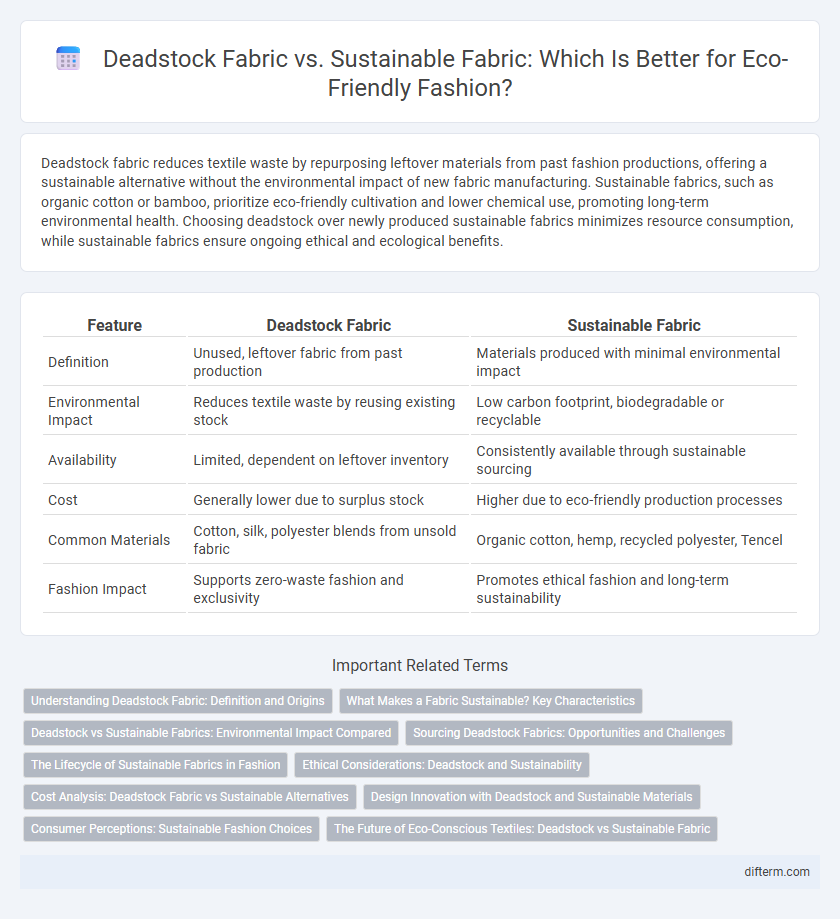Deadstock fabric reduces textile waste by repurposing leftover materials from past fashion productions, offering a sustainable alternative without the environmental impact of new fabric manufacturing. Sustainable fabrics, such as organic cotton or bamboo, prioritize eco-friendly cultivation and lower chemical use, promoting long-term environmental health. Choosing deadstock over newly produced sustainable fabrics minimizes resource consumption, while sustainable fabrics ensure ongoing ethical and ecological benefits.
Table of Comparison
| Feature | Deadstock Fabric | Sustainable Fabric |
|---|---|---|
| Definition | Unused, leftover fabric from past production | Materials produced with minimal environmental impact |
| Environmental Impact | Reduces textile waste by reusing existing stock | Low carbon footprint, biodegradable or recyclable |
| Availability | Limited, dependent on leftover inventory | Consistently available through sustainable sourcing |
| Cost | Generally lower due to surplus stock | Higher due to eco-friendly production processes |
| Common Materials | Cotton, silk, polyester blends from unsold fabric | Organic cotton, hemp, recycled polyester, Tencel |
| Fashion Impact | Supports zero-waste fashion and exclusivity | Promotes ethical fashion and long-term sustainability |
Understanding Deadstock Fabric: Definition and Origins
Deadstock fabric refers to unused textile material that remains from previous production runs, often vintage or surplus stock that was never sold or utilized. Originating from overproduction, canceled orders, or excess inventory, deadstock fabrics present unique patterns and textures unavailable in current market trends. Utilizing deadstock fabric in fashion promotes waste reduction and supports sustainable practices by repurposing existing resources instead of manufacturing new materials.
What Makes a Fabric Sustainable? Key Characteristics
Sustainable fabric is characterized by its minimal environmental impact, often produced from organic, recycled, or renewable materials that reduce waste and pollution. Key attributes include biodegradability, low water usage, non-toxic dyeing processes, and durability, ensuring a longer lifecycle for garments. Deadstock fabric, while repurposed and reducing landfill waste, may not fully meet sustainability criteria if it lacks eco-friendly production or material sourcing.
Deadstock vs Sustainable Fabrics: Environmental Impact Compared
Deadstock fabrics reuse surplus textile inventory, significantly reducing waste by preventing excess materials from ending up in landfills, which directly lowers the environmental footprint of fashion production. Sustainable fabrics, often made from organic or recycled fibers, prioritize resource-efficient cultivation and manufacturing processes aimed at minimizing water consumption, chemical use, and carbon emissions. Comparing the two, deadstock fabric offers an immediate waste-reduction benefit by upcycling existing materials, while sustainable fabrics contribute to long-term environmental health through eco-friendly sourcing and production methods.
Sourcing Deadstock Fabrics: Opportunities and Challenges
Sourcing deadstock fabrics presents unique opportunities by reducing textile waste and offering limited-edition materials that contribute to sustainable fashion. However, challenges include inconsistent supply, limited availability of specific patterns or colors, and difficulty in scaling production to meet demand. Brands must navigate these constraints while leveraging deadstock fabrics to enhance eco-friendly sourcing strategies.
The Lifecycle of Sustainable Fabrics in Fashion
The lifecycle of sustainable fabrics in fashion involves sourcing eco-friendly materials such as organic cotton, hemp, and recycled fibers that minimize environmental impact from cultivation to production. Unlike deadstock fabric--which repurposes leftover textiles from previous production runs--sustainable fabrics emphasize regenerative practices and biodegradability, supporting circular fashion models. By extending product use through durability and recyclability, sustainable fabrics contribute to reducing waste, conserving resources, and lowering the overall carbon footprint of fashion items.
Ethical Considerations: Deadstock and Sustainability
Deadstock fabric minimizes textile waste by repurposing unused, surplus materials, reducing the demand for new fabric production and lowering environmental impact. Sustainable fabrics often involve eco-friendly fibers and manufacturing processes designed to conserve resources and reduce pollution throughout their lifecycle. Both approaches emphasize ethical considerations by promoting resource efficiency and reducing the fashion industry's carbon footprint, but deadstock prioritizes waste elimination while sustainable fabrics focus on renewable and biodegradable materials.
Cost Analysis: Deadstock Fabric vs Sustainable Alternatives
Deadstock fabric typically offers lower upfront costs as it repurposes surplus materials from previous production runs, reducing waste and minimizing raw material expenses. Sustainable fabrics, while often more costly due to ethical sourcing, organic materials, and environmentally-friendly processing, provide long-term economic benefits by aligning with consumer demand for eco-conscious products and reducing regulatory risks. Evaluating cost analysis requires balancing initial expenditure against brand reputation, environmental impact, and market positioning within the fashion industry.
Design Innovation with Deadstock and Sustainable Materials
Deadstock fabric fuels design innovation by repurposing surplus textiles, reducing waste while offering unique textures and patterns that inspire creativity. Sustainable fabrics like organic cotton, hemp, and recycled polyester drive eco-conscious innovation through biodegradable and low-impact production processes, aligning with circular fashion goals. Combining deadstock and sustainable materials enables designers to push boundaries in eco-friendly fashion, creating avant-garde pieces that merge aesthetic appeal with environmental responsibility.
Consumer Perceptions: Sustainable Fashion Choices
Consumers increasingly favor sustainable fabrics for their eco-friendly production and reduced environmental impact, perceiving them as ethical and responsible fashion choices. Deadstock fabric attracts shoppers by offering unique, limited-edition pieces that minimize waste by repurposing surplus materials from previous collections. Both options influence purchasing decisions by aligning with values of environmental consciousness and exclusivity in sustainable fashion.
The Future of Eco-Conscious Textiles: Deadstock vs Sustainable Fabric
Deadstock fabric repurposes surplus or unused textiles, minimizing waste by giving materials a second life, while sustainable fabric emphasizes eco-friendly production processes such as organic farming, low-impact dyes, and water conservation. Innovations in deadstock utilization reduce landfill contributions and resource consumption, offering a practical approach to circular fashion systems. Sustainable fabrics like organic cotton, hemp, and Tencel represent a long-term investment in environmental stewardship by prioritizing renewable resources and reduced chemical inputs.
Deadstock fabric vs sustainable fabric Infographic

 difterm.com
difterm.com